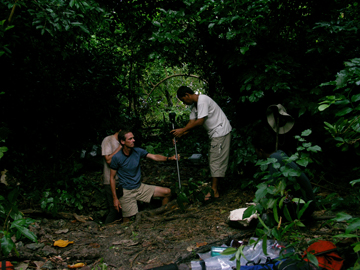|
Web Extra Tuesday, December 12, 2006
Tsunami risk still high in Sumatra
Another major earthquake and tsunami will strike the western coast of Sumatra sometime in the next few decades, according to researchers studying the region's history. And the predicted tsunami has a significant chance of hitting densely populated areas, the team says.
 Tsunami
prediction for Sumatra and the Indian Ocean region has become a priority
since the devastating tsunamis of December 2004 and March 2005. In the
online early edition of the Proceedings of the National Academy of
Sciences, Jose Borrero of the University of Southern California and
colleagues reported on Dec. 4 a new tsunami prediction model based on
past behavior of earthquakes and tsunamis in the area. "This is an
important study and wakeup call for more action to do something to reduce
the risk to coastal populations," says Roland Burgmann, a geologist
at the University of California, Berkeley.
Tsunami
prediction for Sumatra and the Indian Ocean region has become a priority
since the devastating tsunamis of December 2004 and March 2005. In the
online early edition of the Proceedings of the National Academy of
Sciences, Jose Borrero of the University of Southern California and
colleagues reported on Dec. 4 a new tsunami prediction model based on
past behavior of earthquakes and tsunamis in the area. "This is an
important study and wakeup call for more action to do something to reduce
the risk to coastal populations," says Roland Burgmann, a geologist
at the University of California, Berkeley.
Caltech geophysicist Kerry Sieh (center) surveys a fossil coral head in
the jungle of Senau island, off the northern coast of Nias island, Sumatra,
as part of new research that predicts that the western coast of Sumatra
has a strong chance of being hit by another devastating earthquake and
tsunami in the next few decades. Photo is courtesy of Robert Tindol.
To arrive at the model, the team first measured corals — the growth rings of which can help researchers determine both when an earthquake occurred and the extent of seafloor deformation from the temblor. Next, Borrero's team used the seafloor deformation information to determine the approximate sizes of the past quakes, which they could then use to determine the approximate size of the ensuing tsunamis. Once the team had modeled the link between past earthquakes and tsunamis, they tested the model by comparing their results to historical accounts of the events. The team also modeled four future ruptures along various segments of the fault, and the tsunamis that would likely follow such temblors.
The corals indicated that in the long history of major earthquakes that have produced tsunamis along the Sunda megathrust fault off the coast of Sumatra, earthquakes large enough to produce tsunamis tend to occur in twos — the 2004 earthquake is the first since the last couplet in 1797 and 1833. These coupled quakes tend to occur every 130 to 300 years, the researchers reported, as the release of stress on one segment of the Sunda fault actually increases the stress on other segments of the fault. Hence, when the 2004 and 2005 earthquakes ruptured the northern segment of the Sunda fault, they increased the likelihood of a major earthquake on the southern segment, the team wrote.
When compared with the historical records, the model results provided a close match, giving the researchers more confidence in their predictions of future events, Borrero says. It makes sense, says James Dewey of the U.S. Geological Survey in Golden, Colo. "Many see this model and prediction as plausible on the basis of experience with the largest subduction zone earthquakes worldwide," he says.
The historical comparison was not perfect, however, as the model predicted the strength of one past tsunami as weaker than the historical accounts described. Reports from 1797 suggest that a 200-ton English vessel was carried several kilometers inland in Padang, Indonesia, during the 1797 tsunami, but the model suggested inundation would be far less.
Indeed, the model lacks certainty about how large or destructive an actual
tsunami will be, Borrero says, as "we cannot say at all how future
earthquakes will behave." For example, the model cannot predict whether
the next tsunami will spread as far as Sri Lanka and India, as occurred
in 2004, but not in 2005, Burgmann says.
Still, although "there definitely are large uncertainties associated
with these results," the study is a "feasible assessment of
the potential tsunami hazard," says Vasily Titov, chief scientist
of the National Oceanic and Atmospheric Administration Center for Tsunami
Research.
How the accumulated strain on the fault will be released is still a major concern, Dewey says. It could occur in several small earthquakes or one large one. Both are plausible, and the larger one "has to be considered in hazard mitigation efforts," he says.
While many scenarios are possible, Burgmann says, "the core message
of this study should not be surprising: Future great earthquakes and catastrophic
tsunamis will occur along the coast of Sumatra." And that may happen
sooner, rather than later, Borrero says.
Margaret Putney
Geotimes contributing writer
Links:
"Measuring the Sumatra quake,"
Geotimes, May 2006
"Hundreds dead in magnitude-8.7
Sumatra earthquake," Geotimes online, Web Extra, March
28, 2005
Back to top

 Subscribe
Subscribe

